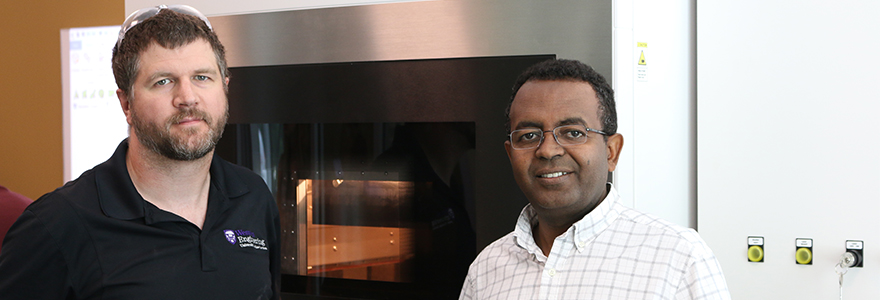Media
Contact
Communications Specialist
Faculty of Engineering
Spencer Engineering Building
Room 2072
Western University
Tel: 519-661-2111 ext. 87015
Email: engineeringcomms@uwo.ca
3D printer sparks partnerships at Western Engineering

Ian Vinkenvleugel, Rapid Prototyping Specialist/Project Lead, University Machine Services and Girma Bitsuamlak, Civil and Environmental Professor, Western Engineering
Western Engineering News | August 16, 2018
A team of Western Engineering researchers, led by Civil and Environmental Professor Girma Bitsuamlak, recently acquired an advanced 3D printer with the capability of printing a variety of complex architectural and civil structure models.
Thanks to a grant from the Ontario Research Fund and the John R. Evans Leaders Fund (JELF), Western Engineering was able to purchase a new, state-of-the-art 3D printer that will facilitate the research of several of the school’s research teams. Working under the support of the Canada Foundation for Innovation, JELF enables its chosen grant recipients to undertake leading-edge research by providing foundational research infrastructure that will help them to become leaders in their field.
Bitsuamlak and his team will focus their research efforts on enhancing the performance of new and existing civil infrastructure for severe weather, such as hurricanes, tornadoes and downbursts, under the constraints of sustainability.
Managed in collaboration with Western’s University Machine Services (UMS), the 3D printer will be used to conduct innovative climate performance assessments and to develop new aeroelastic testing methods by printing models that flex under wind pressure. By directly using different materials to print these aeroelastic models, the 3D printer can drastically reduce the number of technician hours that are currently required to produce the models from separate parts.
Bitsuamlak expressed excitement for the performance quality and partnership opportunities this piece of equipment will provide for Western Engineering’s students and researchers.
“Placing the 3D printer in the hands of UMS and having their experienced technicians handle the operational aspect ensures the quality of the service we get and allows us to stay focussed on the science,” said Bitsuamlak. “Each student will receive high-quality assistance from UMS’s experienced technologists, and new approaches developed by the research team will be channeled back to UMS.”
In terms of partnerships, the printer will also be made available to researchers in the field of Wind Engineering and to Western Engineering researchers in general with nominal service fees used to recover material and operation costs and printer maintenance.
Bitsuamlak added that extending the machine’s accessibility throughout the Faculty of Western Engineering is a win-win situation for all involved because it will enhance cross-functional learning opportunities for all engineering research students and lower the cost of printing.
“This type of collaboration between various units and research teams here at Western Engineering will create the best scenario for our student training and research continuity,” he said.
For more information on Wind Engineering at Western, visit here.
For more information on Western’s University Machine Services, visit here.

